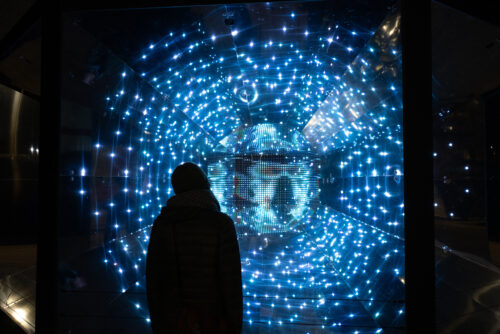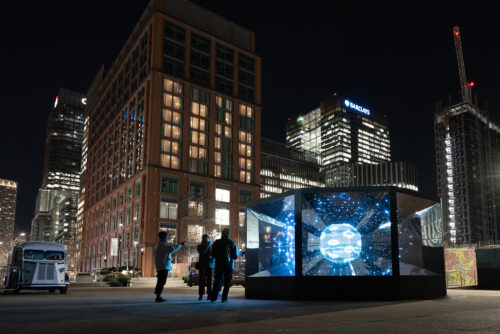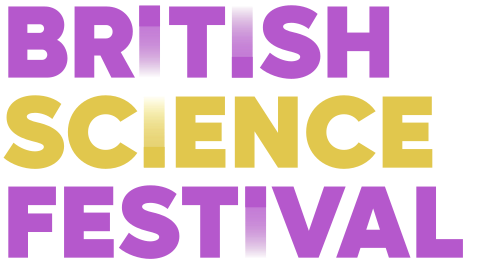An audio-described tour of Geist
Neutrinos – also known as ghost particles – are abundant but minuscule and extremely hard to detect. Tens of trillions of neutrinos from the sun stream through your body every second, but you can’t feel them. ‘Geist’ is inspired by neutrino detector equipment and uses neutrino oscillation measurements from the T2K neutrino experiment in Japan. It explores the work taking place to trace neutrinos, and asks what these tiny particles might reveal about the universe.

One of the many mysteries surrounding neutrinos is that the three different types of neutrinos can change into each other. We know there are three neutrino types, the electron, muon, and tau neutrino, to accompany their charged heavier cousins, the electron, muon and tau (the latter two are essentially just heavier electrons).
However, depending on the neutrino’s energy and distance travelled, a neutrino created as one type may be detected as a different type altogether. This is a process called “neutrino oscillation” and scientists believe understanding neutrino oscillations could potentially shine light on why the universe exists.
Neutrinos are extremely elusive and Particle physicists need to use mammoth neutrino detectors to hunt and trace these so called ‘ghost particles’. Only on the extremely rare occasion that a neutrino interacts by hitting an atom in the detector can these particles be detected, through new charged particles produced by the interaction.
Inspired by these enormous neutrino detectors, Geist (from the German word for “ghost”) is an exploration of the complex game of ‘hide and seek’ that scientists play to find and provide evidence for the existence of these particles. T2K uses a muon neutrino beam made at the JPARC particle accelerator, and observes this beam at two sites, a Near site at JPARC to measure the neutrinos before oscillations, and a Far site 295km away, using the giant Super – Kamiokande detector.
Hunt for the elusive ghost particle at Liverpool ONE and interact with particles of light. ‘Geist’ – a large-scale art installation – has arrived at the Liverpool ONE and you’re invited to bring it to life! Use your body and movements to activate the artwork and illuminate the connections between art, technology and science.
Artwork by This is Loop (Harriet Lumby and Alan Hayes), Sound design by Dan Bibby, Creative coding by Motus Arts. Physics and data collaboration with physicists at the Rutherford Appleton Laboratory (STFC) and Physics Department at Oxford University.
This installation is programmed in collaboration with Culture Liverpool.
Instagram: @this_is_loop
To delve deeper into the world of particle physics, some of the world’s leading particle physicists will discuss how we are starting to understand more about the fundamental building blocks of the universe at the Festival on Thursday 11th September.
Join, Graziano Venanzoni (University of Liverpool), Saskia Charity (University of Liverpool), Mark Thomson (CERN) and Jocelyn Monroe (University of Oxford) to find out about fascinating particle physics projects including the Muon g-2 experiment, the Darkside-20k experiment, and the Large Hadron Collider.
Researchers from the Department of Physics (University of Liverpool) will also showcase real particle detectors, demonstrate how they work and explain how experiments are designed.
People can also join an interactive virtual tour of Boulby Underground Laboratory in Yorkshire, where scientists are searching for the elusive ‘dark matter’ that makes up most of the mass of the universe.

